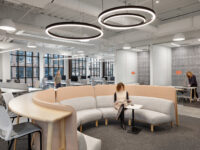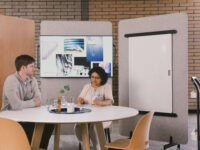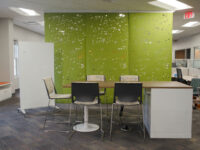Collaboration has become the cornerstone of modern workplaces, and the trend of collaborative spaces is on the rise. These new types of office spaces are designed to foster teamwork and innovation, allowing employees to collaborate effortlessly, share ideas, and create groundbreaking solutions. To design collaborative spaces for optimal productivity, efficiency and creativity, multiple elements must combine for a beneficial result.
Benefits of Collaborative Spaces
For a successful organization, collaborative spaces bring a multitude of advantages. First and foremost, these spaces promote enhanced creativity and innovation. When employees from diverse backgrounds come together, ideas flow freely and new perspectives emerge. This leads to the development of innovative products and services, giving companies a competitive edge in the market.
As more companies blend hybrid and remote working solutions into their structure, a collaborative space generates even more benefits to an in-person workforce. A communal area for brainstorming and interdepartmental communication can bring purpose back to intentional in-person work, and take your work culture from your employees into the physical environment. The embodiment of your company’s values in a functional collaborative space uplifts your business and brings better productivity.
Designing The Space
To create successful collaborative spaces, several key components need to be considered:
Flexible Furniture Layouts
Collaborative spaces should have adaptable furniture layouts that cater to different team sizes and activities. Movable furniture allows teams to reconfigure the space based on their specific needs, whether it’s a brainstorming session, a team meeting, or group work.
Technology Integration
Integrating digital tools and smart devices is crucial for seamless collaboration. Modern workplaces heavily rely on technology for communication and project management, so collaborative spaces must be equipped with the latest technologies that are easy to access and device-compatible.
Aesthetics and Ambiance
The physical environment plays a significant role in creativity and productivity. Collaborative spaces should be designed to create a welcoming and inspiring atmosphere. Thoughtful use of colors, lighting, and greenery can enhance creativity and bring a positive mood to coworker interactions.
Spatial Design and Flow
The layout of the collaborative space should encourage movement and interaction. Proper zoning can designate areas for focused work and social interactions, creating a balanced environment that supports different aspects of collaboration.
Reflecting Organizational Culture and Values
Crafting collaborative spaces goes beyond functionality; they must mirror the distinctive core values and culture of the organization. The integration of branding elements and design components that resonate with the company’s mission and vision transforms these spaces into an embodiment of the organization’s essence. This transformation is more than aesthetics; it cultivates an environment where employees experience a deep-rooted connection to the organization’s values. King Business Interiors is your partner in this journey, equipped to translate your brand into a cohesive and inviting workspace that stimulates collaboration and pride.
Let’s Collaborate!
Collaborative spaces are transforming modern workplaces, fueling creativity, and driving innovation. By designing these spaces with flexibility, technology integration, aesthetics, and collaboration etiquette in mind, your company can optimize teamwork and reap the numerous benefits that come with it. As businesses seek to align their workspace design with their culture and values, King Business Interiors can play a pivotal role in providing collaborative furniture solutions that empower organizations to achieve their collaboration goals.
Contact us today and let’s design a space unique to your work and committed to team synergy. Embracing the rise of collaborative spaces is not just a trend but a strategic move to enhance productivity, creativity, and overall employee satisfaction in the ever-evolving world of work.



